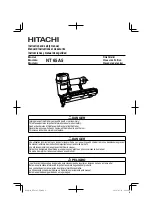
3
Meet the IronForce Nailer by Campbell Hausfeld
Designed for framing, trusses, sub-floors, sheathing, exterior decks, and
pallet/create assembly, the IronForce Nailer from Campbell Hausfeld features
convenient top loading magazines, adjustable exhaust, and an adjustable depth of
drive mechanism. Other features include a no-mar tip and a single cycle trigger.
Figure 1 - Specifications & components




































